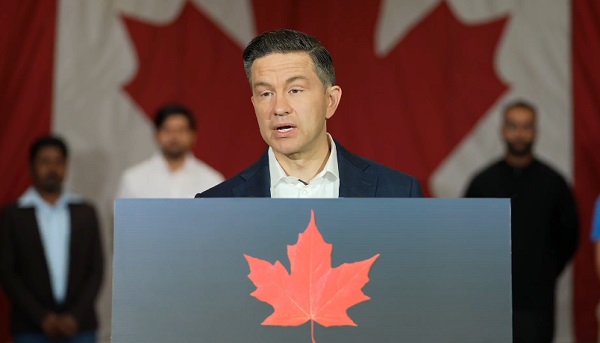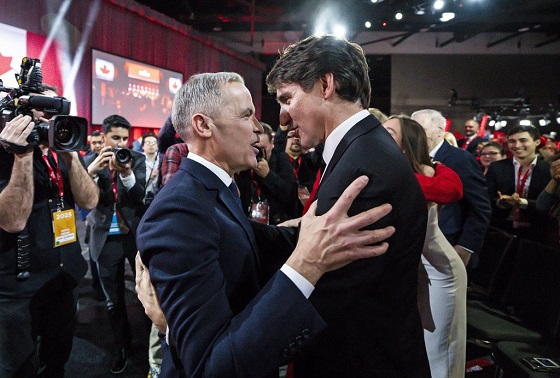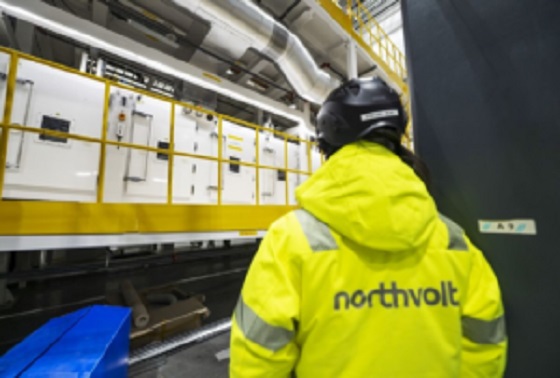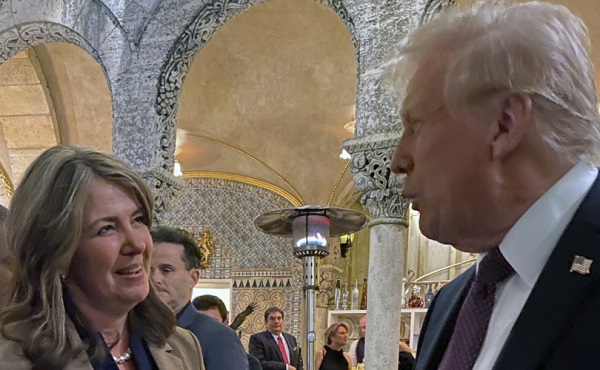Business
Poilievre calls on Carney to immediately scrap the Temporary Foreign Worker Program

News release from the Conservative Party of Canada
Today, the Hon. Pierre Poilievre, Leader of the Conservative Party of Canada and the Official Opposition, and the Hon. Michelle Rempel Garner, Shadow Minister for Immigration, announced their plan to tackle the Liberal unemployment crisis by permanently scrapping the Temporary Foreign Worker (TFW) program and immediately ending new permits.
“Prime Minister Carney has failed to meet his own already excessive immigration targets and now he’s on track to issue the highest number of TFW permits ever in a single year,” Poilievre said. “It’s time to take decisive action to protect our youth and workers.”
Under the Liberals, too many corporations are relying on cheap foreign labour while Canadians pay the price. Recent data shows a 7.4 percent increase in Employment Insurance requests since Carney took office (504,110 in March to 541,430 in June), while almost 400,000 Canadians have been searching for work for over two years – outside of the pandemic, this is the highest share of long-term unemployment since February 1998.
Youth employment is at its lowest in more than a quarter-century (outside the pandemic), while an oversaturated job market continues to suppress wages even for the gainfully employed. Companies like Tim Hortons, the once beloved coffee shop that gave a first paycheque to countless Canadian teens, have hired an almost unimaginable number of TFWs – 1,131 percent more for Tim Hortons over just four years alone.
“We know why a foreign-owned mega chain wants to be greedy – it’s good for their corporate profits – but our immigration system doesn’t exist to pad their bottom line,” Poilievre said. “That’s why the government should immediately stop issuing new TFW permits, and end this wage-suppressing, opportunity-stealing program.”
“Not long ago, young Canadians could gain vital skills in entry-level jobs, earn enough to pay for school, and build a future,” said Rempel Garner. “In return, employers built a skilled domestic workforce. But the Liberals broke that deal, leading to staggering youth unemployment and heartbreaking stories of graduates sending hundreds of resumes without a single callback.”
Over the last decade, TFWs have ballooned to almost two percent of our total private sector workforce. The impact is dramatic, considering that nearly three-quarters of these temporary immigrants earn less than the median income and exert downward pressure on wages.
That’s as Canadians struggle with an unemployment crisis that CIBC says matches “levels typically only seen during recessionary periods.” In June 2009, the height of the Great Recession, 684,200 Ontarians were out of work, 16,300 fewer than the 700,500 reported this July.
Yet, we are still bringing in record amounts of predominantly low-skilled foreign labour. Carney’s government has issued 105,000 new Temporary Foreign Worker permits in the first six months of 2025 alone. Despite a promised cap of 82,000, the Liberals are on track to issue the most TFW permits ever.
“As Canada’s economy slides into recession, productivity hits rock bottom, and AI disrupts the job market – all while we grapple with housing and healthcare crises – Canadian youth are trapped,” Rempel Garner added. “They can’t buy homes or start families without good-paying jobs, but they can’t get those jobs without experience, lost to competition from temporary foreign labour.”
Under this urgently-needed plan, the Temporary Foreign Workers program would be permanently abolished with a separate, standalone program for legitimately difficult-to-fill agricultural labour. For ultra-low-unemployment regions, there will be a transition period of, at most, five years while the program winds down, but no new permits will be issued anywhere in Canada.
It’s time for Canadian jobs for Canadian workers. If Mark Carney is serious about fixing the immigration system his party broke, he would immediately enact these reforms. Conservatives will always fight to protect our youth and all Canadians from reckless policies that lock them out of work and suppress their wages.
Automotive
Canadians rejecting Liberal’s EV mandates because consumers are rational

From Resource Works
Bad policy, not misinformation, is to blame for the decline in EV sales
It was a clever move for federal minister Gregor Robertson to stand in Victoria and blame the oil and auto industries for spreading “misinformation” about electric vehicles.
If people don’t follow a government order, then someone else must have lied to them.
But the truth is simpler, and more uncomfortable for Ottawa and Victoria: Canadians are against aggressive EV mandates because the policies behind them are not based on reality.
Politicians have been pushing electric vehicles (EVs) as a cornerstone of the fight against climate change for years, promising a cleaner future through ambitious mandates and generous rebates.
All of this effort looked good on paper: passing laws, handing out thousands (millions, billions) in subsidies, paving the way for Canada’s transition to an electric future.
But, in real life, it’s just not working out this way.
Why? Because instead of crafting long-term rules based on the realities of infrastructure, cost, and consumer choice, Ottawa rushed ahead with policies that ignored market signals.
They assumed subsidies would keep EV sales flowing indefinitely, only to be shocked when sales plummeted once the rebates dried up.
Canadians are responding rationally to high prices, unreliable charging networks, and impractical mandates.
Not long ago, Ottawa set ambitious, unattainable targets: 20 percent zero-emission vehicle sales by 2026, 60 percent by 2030, and 100 percent by 2035.
British Columbia went further, aiming for 26 percent by 2026, 90 percent by 2030, and 100 percent by 2035.
In theory, it looked achievable. In practice, it’s been a wake-up call.
The numbers tell the story. Statistics Canada reported that EVs accounted for 18.29 percent of new vehicle sales in December 2024. Just four months later, when Ottawa’s iZEV program ran out of funds and provincial rebates ended, that figure crashed to 7.53 percent.
In British Columbia, once a leader in EV adoption, the market share dropped from nearly 25 percent in mid-2024 to 15 percent a year later.
Quebec, long the most EV-friendly province, saw a similar decline when its $7,000 subsidy was slashed nearly in half.
Why? Canadians have been very clear.
Cost is the biggest barrier, according to polls like this one from Ipsos in 2025. But this isn’t the only issue.
Ipsos found 56 percent of British Columbians oppose EV mandates, with even higher resistance among older households and those outside Metro Vancouver. People resent being told they must buy expensive cars they can’t easily charge or fully trust in harsh winters.
Subsidies made high sticker prices tolerable for middle-class families, but when the rebates vanished while mandates and fines remained, buyers walked away.
Barry Penner of the Energy Futures Institute put it bluntly: governments “put the cart before the horse,” demanding widespread adoption before ensuring affordability or infrastructure.
The financial penalties for automakers are steep. Missing federal targets by 10 percent could mean hundreds of millions in fines.
In British Columbia, dealers face $20,000 penalties for every gas-powered car sold over the mandated ratio. Those who can’t comply often buy credits—frequently from Tesla, a California-based company that benefits while Canadian businesses foot the bill. These rules aren’t just hitting “Big Oil”; they’re straining local dealers and sending money abroad.
Infrastructure is another glaring issue. Ottawa estimates Canada has 33,700 chargers today but needs 679,000 by 2040—an average of 40,000 new chargers annually for 15 years, a pace experts call unrealistic.
In British Columbia, Penner notes the province has just 5,000 chargers now and needs 40,000 more by 2030. Meeting the 2035 mandate would also require electricity equivalent to two additional Site C dams, even as B.C. relies on 20 to 25 percent of its power from external sources, often fossil fuels.
Canadians aren’t against cleaner technology—they’re against being forced into choices that don’t fit their lives. The frustration stems from policies that feel disconnected from the realities of cost, convenience, and infrastructure. More blame or moralizing won’t fix this.
Penner has urged governments to “take our foot off the gas and realign our policies with reality.”
That could mean reinstating rebates if mandates persist, investing heavily in charging networks, or setting broader emissions targets that give consumers real choices instead of rigid quotas.
The EV dream will keep stalling unless that happens. It’s not because Canadians don’t know what’s going on; it’s because governments made decisions based on wishful thinking.
Business
Ottawa should should follow Quebec’s lead and pull the plug on EV corporate welfare project

The Canadian Taxpayers Federation is calling on the federal government to cut its corporate welfare for Northvolt’s electric vehicle battery plant following news that the Quebec government is pulling its funding.
“The federal government should follow Quebec’s lead and pull the plug on this risky corporate welfare,” said Franco Terrazzano, CTF Federal Director. “The Carney government can save taxpayers billions if it stops the flow of cash to multinational corporations now.”
The government of Quebec is “pulling the plug on a $7-billion electric-vehicle battery project near Montreal and trying to recoup some of its investment,” the Canadian Press reported.
The federal government announced more than $4 billion in subsidies to Northvolt’s electric-vehicle battery project, while the Quebec government announced more than $2 billion.
Of the federal corporate welfare, about $3.5 billion is production subsidies while $1.3 billion is for “construction and other support,” according to the Parliamentary Budget Officer. The federal government announced subsidies to help build the first phase of the plant but “hasn’t yet disbursed any funds,” according to the Globe and Mail.
The federal government put taxpayers on the hook for up to $31.4 billion for subsidies for battery factories and the electric vehicle supply chain, according to the PBO.
“The government is broke and it should not give taxpayers’ money to corporations,” Terrazzano said. “The government should be growing the economy by cutting taxes and red tape, not by making risky bets with taxpayers’ money.”
-

 Business1 day ago
Business1 day agoCanadians don’t just feel worse off—they actually are
-

 Censorship Industrial Complex1 day ago
Censorship Industrial Complex1 day agoComedy writer Graham Linehan arrested in UK for criticizing gender ideology on social media
-

 COVID-191 day ago
COVID-191 day agoHow effective were COVID vaccines really?
-

 Bruce Dowbiggin2 days ago
Bruce Dowbiggin2 days agoMitch Ado About Marner: Angry Toronto Fans Needed A Scapegoat
-

 Artificial Intelligence1 day ago
Artificial Intelligence1 day agoAI Drone ‘Swarms’ Unleashed On Ukraine Battlefields, Marking New Era Of Warfare
-

 COVID-191 day ago
COVID-191 day agoCanada issues nationwide warrant for Freedom Convoy protester seeking asylum in the US
-

 Health1 day ago
Health1 day agoRobert F. Kennedy Jr. wows to rebuild public trust in CDC
-

 Energy1 day ago
Energy1 day agoWaiting to Launch a New Oil Pipeline to the West Coast Until the Trans Mountain Reaches Full Capacity is a Bad Idea







